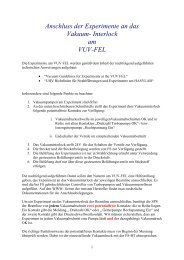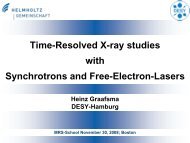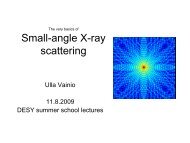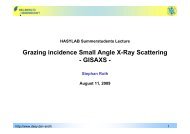The OTIS Reference Manual - Hasylab
The OTIS Reference Manual - Hasylab
The OTIS Reference Manual - Hasylab
You also want an ePaper? Increase the reach of your titles
YUMPU automatically turns print PDFs into web optimized ePapers that Google loves.
7.2 <strong>OTIS</strong>1.1 Sample Measurements<br />
Digital to Analog Converter:<br />
Figure 10 shows the behavior of the 4 digital to analog converters which provide the threshold<br />
voltages for the ASD discriminator chips. <strong>The</strong> outputs of the DACs are now buffered and therefore<br />
able to drive currents up to 600µA. Figure 10 shows how the output voltages at an external<br />
load (1.2kOhm) vary with programming of the DAC registers. Extra design effort went into chip<br />
version <strong>OTIS</strong>1.2 in order to decrease the spread in between all 4 channels (which is ≈80mV for<br />
<strong>OTIS</strong>1.1).<br />
Output Voltage [mV]<br />
2500<br />
2000<br />
1500<br />
1000<br />
500<br />
Digital to Analog Converter<br />
1.2kOhm load<br />
DAC 0<br />
DAC 1<br />
DAC 2<br />
DAC 3<br />
0<br />
0 50 100 150 200 250<br />
Bin Number<br />
Figure 10: DAC Measurement<br />
Vctrl [mV]<br />
2500<br />
2000<br />
1500<br />
1000<br />
500<br />
DLL Lock Range<br />
(Room Temperature)<br />
0<br />
20 30 40 50 60<br />
Clock Frequency [MHz]<br />
Figure 11: DLL Lock Range<br />
DLL Lock Range:<br />
Figure 11 combines data from 2 different measurements concerning the lock range of the DLL. <strong>The</strong><br />
diagram shows the control voltage of the single delay elements against the LHC clock frequency.<br />
Data from 25MHz to 46MHz has been obtained with standard chip settings. <strong>The</strong> chip operated<br />
at a different supply voltage (Vdda = 3.3V instead of 2.5V) from 47MHz to 60Mhz. <strong>The</strong> resulting<br />
offset in Vctrl has been taken into account for this summary. At room temperature and provided<br />
that reset is active before the clock is running, the DLL reaches its lock state for clock frequencies<br />
that range from 25MHz to 60MHz.<br />
Drift Time Measurement:<br />
Figure 12 shows the linear dependency between input signal delay (x-axis) and drift times (y-axis)<br />
derived from the input signal. <strong>The</strong> drift time data that contribe to this figure ranges from 0 to<br />
63. Thus data only represents an overall drift time range of 25ns. In this diagram 0ns drift times<br />
belong to an input signal delay of 6ns and range to 24.9ns (resp. 30.9ns input signal delay). <strong>The</strong><br />
drift time figures repeat below an input signal delay of 6ns and above a delay of 30.9ns .<br />
Differential Non-Linearity:<br />
To calculate a figure for the differential non-linearity, several million drift times derived from random<br />
input signals need to be stored and analyzed. <strong>The</strong> DLL bin sizes can be calculated from the<br />
histogram of all drift times. Now the difference in bin size of always two subsequent DLL bins<br />
can be calculated. But one needs to take into account that always two bins of different size form<br />
one delay element of the DLL. A sample diagram displaying bin size differences against the bin<br />
number is shown in figure 13. Now the sum of the biggest and (the absolute value of the) smallest<br />
bin size difference is called differential non-linearity. <strong>The</strong> data of diagram 13 results in a DNL of<br />
(1.25 ± 0.04)LSB or (489 ± 16)ps. <strong>The</strong> dominating contribution to the DNL originates from an<br />
18










